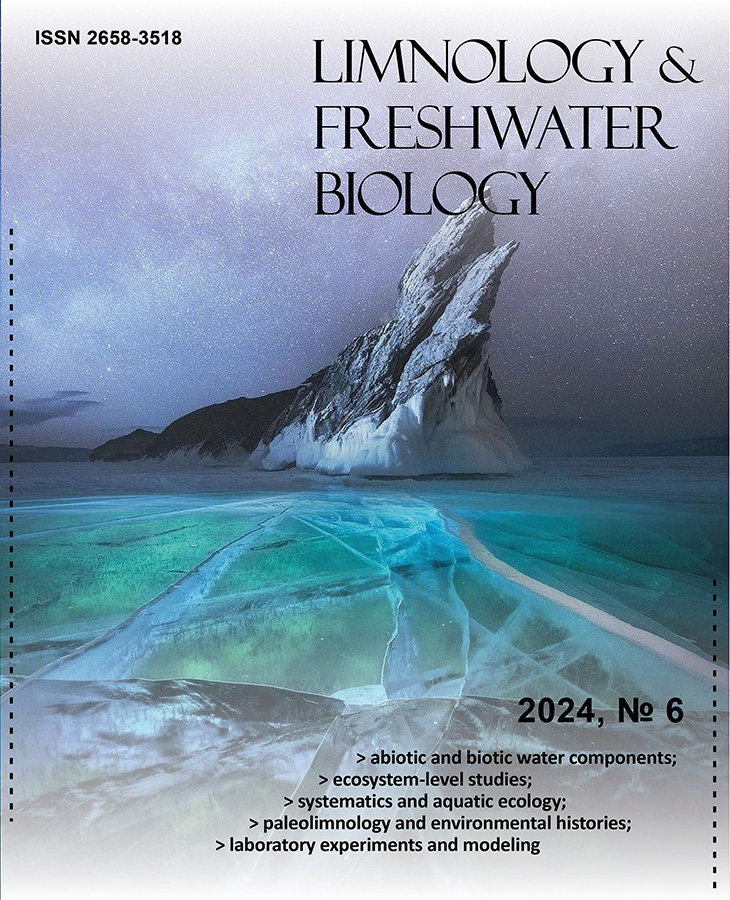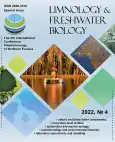Lithochemical parameters in equilibrium systems of modern sedimentation in lakes and on the sea shelf
- Authors: Kalugin I.A.1, Gaskova O.L.1,2, Meydan A.F.3, Babich V.V.1, Markovich T.I.1, Astakhov A.S.4
-
Affiliations:
- Sobolev Institute of Geology and Mineralogy SB RAS
- Novosibirsk State University
- Yuzuncu Yil University
- Ilyichev Pacific Oceanological Institute FEB RAS
- Issue: No 4 (2022)
- Pages: 1429-1431
- Section: Articles
- URL: https://journal-vniispk.ru/2658-3518/article/view/289359
- DOI: https://doi.org/10.31951/2658-3518-2022-A-4-1429
- ID: 289359
Cite item
Full Text
Abstract
The work combines physicochemical and statistical modeling in the description of marine and continental salt water bodies. Sedimentary systems consist of aluminosilicate, carbonate and organogenic source material. Paleoclimatic changes are traditionally considered in the time scale. However, the real fluctuation amplitude of the target natural parameter is usually absent or has insufficient resolution for quantitative paleoclimatic reconstructions. Accessible quantitative analysis of time series is based on mineralogy and geochemistry of bottom sediments. Ahalytical complex includes X-ray phase diagnostics of minerals, SEM and XRF analysis of bulk chemical composition, isotopic dating and counting of annual rhythms. Modern high-resolution techiquem like scanning XRF SR with a measurement step of 1 mm successfully provides the necessary synchronization between analytical data and instrumental seasonal-annual observations. Multiple regression methods are used to calculate the transfer functions for transforming the elemental composition of sediments into time series of the desired target environment. Additional physicochemical equilibrium estimates of sedimentation were calculated, confirming the convergence of the parameters of the selected multisystem (rock + liquid + gas) with environmental conditions. For equilibrium systems, time series of absolute values of the desired parameters, such as temperature, salinity, pH, redox environment, etc., were calibrated with synchronous weather and climate fluctuations. In particular, the reconstruction of marine sediments opened up the prospect of studying the periodicity of ice-free periods in the Arctic Ocean, using quantitative estimates of external conditions from the lithochemistry of bottom sediments.
Keywords
Full Text
1. Introduction
The work combines physicochemical and statistical modeling in the description of marine and continental salt water bodies. Sedimentary systems consist of aluminosilicate, carbonate and organogenic source material. Paleoclimatic changes are traditionally tied to a time scale. However, the real fluctuation amplitude of the target natural parameter is usually absent, or has insufficient resolution for quantitative paleoclimatic reconstructions. Purposeful detailed sampling and quantitative analysis of time series are preferable. In accordance with the source of material and the predominant mechanism of accumulation, in the general case, three lithochemical proxy groups are distinguished: 1) clastogenic with the participation of Rb, Sr, Zr, density (clays and other slightly weathered mineral particles), 2) chemogenic - Ca, Mg, Sr carbonates and organic redox products, and 3) degrading organic masses with a wide range of water-soluble material. Currently, we are considering climate-dependent parameters in reactive clastogenic-biogenic-chemogenic systems, based on the fact that the identified geochemical signals of bottom sediments reflect changes in the area of interest. These are, for example, the components Br, Mo/Mn, Rb/Sr, Sr, Ca/Sr, Co-Inco, etc. known in the literature, and calibrated by the synchronous series of hydrometeorological observations. For the analysis of the paleoenvironment, Lake Van, located in the semiarid zone of the continental climate, as well as shallow-water (shelf) deposits in the Siberian Arctic (Chukchi Sea) were selected. A comparative study of lacustrine and marine sedimentation makes it possible already at the first stage to calculate the parameters of equilibrium mineral formation and evaluate the correctness of reconstructions by the physicochemical approach. Experience shows that the more features, the better the correlation between proxy and instrumental weather data on the transfer function calibration interval.
2. Materials and methods
X-ray phase diagnostics of minerals, SEM and XRF analysis of bulk chemical composition, isotopic dating and counting of annual rhythms. High-resolution geochemical analysis (scanning XRF SR with a measurement step of 0.5 mm) fully provides the necessary synchronization between analytical data and instrumental seasonal-annual observations. Multiple regression methods were used to calculate the transfer functions for transforming the elemental composition of sediments into time series of the desired target environmental parameters. The primary minerals of the deposits and the bulk chemical composition of the basin water are given in tables 1 and 2. Table 1 was used as initial information in the simulation, and Table 2 served to check the specified ratios of the main proxies.
Table 1. Mineral composition of lacustrine (Lake Van) and marine sediments (shelf of Chukchi Sea).
Van Lake sample 2015– 3, age 1090 – 1100 yrs BP | Smectite and illite-smectite ~ 40-50%, muscovite type mica ~ 10-15%, chlorite ~ 5%, calcite <5%, aragonite <5%, NaCl <5%, quartz <5% , kaolinite <5%, dolomite <5%, monohydrocalcite <5%, possibly thenardite |
Chukchi Sea, Station В 7, age 220– 230 yrs BP | Muscovite type mica ~ 25-30%, quartz ~ 25-30%, plagioclase and Kfs ~ 10-20%, Fe-Mg chlorite ~ 5-15%, NaCl <5%, monohydrocalcite <5%, hematite or pyrite <5%, amphibole <5%, illite-smectite <5% |
Table 2. Chemical composition of sediments, %wt.
Basin | SiO2 | TiO2 | Al2O3 | Fe2O3 | MnO | MgO | CaO | Na2O | K2O | P2O5 | SO3 | Ca/Sr | LOI | Sum |
Van Lake | 26,86 | 0,27 | 5,46 | 2,95 | 0,09 | 9,18 | 19,55 | 2,99 | 0,41 | 0,19 | 2,21 | 123 | 28,02 | 98,18 |
Chukchi Sea | 59,33 | 0,68 | 12,3 | 5,64 | 0,05 | 2,54 | 1,7 | 3,72 | 2,36 | 0,19 | 0,38 | 24 | 10,41 | 99,3 |
The sediments of the lake Van has a large content of carbonates (CaO ~ 20%), and on the Arctic shelf - silty clays (SiO2 ~ 60%, CaO < 2%). The modern salinity of Lake Van is 22 g/l, and the Ca/Sr value ranges from 70 to 170 (average 123), while in shelf sediments the ratio ranges from 14 to 31 (average 24, see Table 3).
Table 3. Mineral composition model of the bottom sediments of the Chukchi Sea and Lake Van after interaction of 100 g solid and 1 kg of solution at 10°C, Eh 0.3V, pCO2 10-3.5 atm. Calculated pH and species of calcium and strontium in solutions are shown (%).
Mineral | Chukchi Sea,% | Van Lake,% | Parameter | Chukchi Sea,% | Van Lake,% |
Quartz | 25,67 | 26,28 | рНcalc. | 8,4 | 9,8 |
Hematite | 9,06 | 0,00 | Ca2+ | 85,00 | 35,72 |
Calcite | 7,67 | 17,02 | CaCO30 | 0,89 | 60,45 |
Strontianite | 0,04 | 0,04 | CaSO40 | 13,22 | 3,83 |
Muscovite | 29,19 | 32,45 | CaCl+ | 0,01 | no |
Chlorite | 16,65 | 9,06 | Sr2+ | 77,11 | 48,16 |
Kaolinite | no | 15,15 | SrCO30 | 0,60 | 44,34 |
Albite | 7,38 | no | SrSO40 | 17,39 | 7,50 |
Microcline | 4,34 | no | SrCl+ | 4,31 | no |
Ca/Sr | 14-31 | 70-170 |
Based on the mineralogical and bulk chemical analysis of the reservoirs, physicochemical equilibrium estimates of sedimentation were calculated, confirming the convergence of the parameters of the selected multisystem (rock + liquid + gas) with environmental conditions.
3. Results
In addition to the well-known geochemical features, Ca/Sr is considered as a permanent salinity index of basin and pore water, which are controlled by climatic factors and are modeled by the water/rock ratio in the calculated diagrams (Tret’yakov et al., 2012). In a setting of stable water balance of lakes, the value of Ca/Sr in the sediment is inversely proportional to the salinity of the basin and pore water. For example, the maximum freshening in Lake Van over the past millennium is associated with a sharp rise in Ca/Sr during the period of massive melt water inflow immediately after the Maunder minimum.
Strontium is fixed in the sediment as an isomorphic admixture of strontianite in biogenic aragonite due to the similar crystallographic lattice in these carbonates. The Gibbs free energies of the formation of carbonates without Mg differ insignificantly. So calculating the equilibrium reveals aragonite and monohydrocalcite are released only when the formation of calcite is suppressed (calculation of quasi-equilibria).
Using the “Khch” program, Moscow State University, (Shvarov, 2008) the equilibrium of Lake Van and the shelf of the Chukchi Sea with brine and sea water, respectively, was calculated . Thermodynamic calculations were carried out in a heterophase 18-component system H-O-C-Cl-N-S-P-Al-Si-Na-K-Ca-Mg-Mn-Fe-Ba-Sr-Br at 10°C and a total pressure of 1 atm according to the KhCh program as well as to the GIBBS algorithm and the UNITHERM thermodynamic database. When calculating water-rock, 100 g of the solid phase was taken.
4. Discussion and conclusions
Table 3 shows the results of calculations of the solid phase, where minerals content is normalised to 100%). After interaction water/rock in an acid-base environment (pH), the calculated result corresponds to the values measured in situ. This makes it possible to predict a decrease in the concentration of both calcium and strontium in solution due to an increase in the stability of (Ca,Sr)CO3(s) solid solutions. At the same time, there is also a change in the types of both soluble Ca and Sr. If Ca2+ and Sr2+ prevail in sea water and the proportion of sulfate complexes is 13 and 17%, respectively, then in lake water Na-HCO3- Type SO4, carbonate complexes in the form of MeCO3 and MeHCO3+ play a significant role up to 60 and 44%, respectively. When we simulated equilibrium at a water/rock ratio of 10, that is, these are the first stages of interaction, marked by intense chloritization (Chukchi Sea, 16.65%) or kaolinization (Van, 15.15%). The nonequilibrium of waters with clastic aluminosilicates (plagioclase, amphibole, etc.) has a complex chemical nature associated with the influence of hydrolysis products on various subsequent chemical processes.
Nevertheless, a stationary, equilibrium-nonequilibrium system develops everywhere. With a decrease in the water/rock ratio by a factor of 100, stable smectites and illite-smectites (pore aquatic environment) are already observed. Under these conditions, the Van Lake deposits are more mature, and accompanied by a high proportion of organic and clay components and a higher Ca/Sr ratio as well. The presence of pyrite in the sediments of the Chukchi Sea indicates reducing conditions and the activity of sulfate-reducing microorganisms. Under model conditions, they correspond to the value Eh -0.3 V.
Acknowledgements
The work is done on state assignment of IGM SB RAS. It was supported by RFBR (Russia, project 15-55- 46001) and TUBITAK (Turkey, project 114Y825) and by RSCF (Russia, project 21-17-00081).
Conflict of interest
The authors declare no conflict of interest.
About the authors
I. A. Kalugin
Sobolev Institute of Geology and Mineralogy SB RAS
Author for correspondence.
Email: ikalugin@igm.nsc.ru
Russian Federation, 3 Akademik Koptyug ave., Novosibirsk, 630090
O. L. Gaskova
Sobolev Institute of Geology and Mineralogy SB RAS; Novosibirsk State University
Email: ikalugin@igm.nsc.ru
Russian Federation, 3 Akademik Koptyug ave., Novosibirsk, 630090; 1 Pirogov str., Novosibirsk, 630090
A. F. Meydan
Yuzuncu Yil University
Email: ikalugin@igm.nsc.ru
Faculty of Geological Engineering
Turkey, Van, 65000V. V. Babich
Sobolev Institute of Geology and Mineralogy SB RAS
Email: ikalugin@igm.nsc.ru
Russian Federation, 3 Akademik Koptyug ave., Novosibirsk, 630090
T. I. Markovich
Sobolev Institute of Geology and Mineralogy SB RAS
Email: ikalugin@igm.nsc.ru
Russian Federation, 3 Akademik Koptyug ave., Novosibirsk, 630090
A. S. Astakhov
Ilyichev Pacific Oceanological Institute FEB RAS
Email: ikalugin@igm.nsc.ru
Russian Federation, 43 Baltiyskaya str., Vladivostok, 690041
References
- Shvarov Yu.V. 2008. HCh: New potentialities for the thermodynamic simulation of geochemical systems offered by windows. Geochemistry International 46: 834. doi: 10.1134/S0016702908080089
- Tret’yakov G.A., Kalugin I.A., Dar’in A.V. et al. 2012. Physicochemical conditions of seasonal carbonate precipitation in Shira Lake (Khakasia). Doklady Earth Sciences 446(1): 1099-1101. doi: 10.1134/S1028334X12090152
Supplementary files










